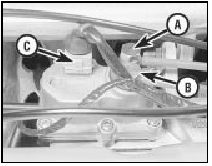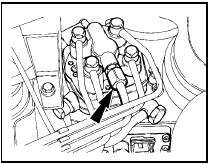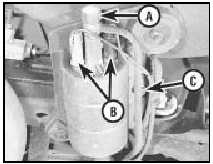Fuel pump - removal and refitting
Note: Refer to the precautions at the end of Section 1 before proceeding.
Removal
1 The fuel pump is bolted to the underside of
the car just to the rear of the fuel tank. For
access raise and support the car securely at
the rear.
2 Disconnect the battery earth lead.
3 On the K-Jetronic system relieve the system pressure by slowly loosening the fuel feed pipe union at the warm-up regulator (see illustration). Absorb the fuel leakage in a cloth.

6.3 Warm-up regulator fuel feed pipe (A), outlet pipe (B) and wiring
multi-plug (C)
4 On the KE-Jetronic system relieve the system pressure by slowly loosening the cold start valve union on the top of the fuel distributor (see illustration). Absorb fuel leakage in a cloth.

6.4 KE-Jetronic system cold start valve pipe union (arrowed) on fuel
distributor
5 Clamp the fuel inlet hose midway between the tank and the pump using a brake hose clamp, self-locking grips or similar. If the fuel level in the tank is low you may prefer to drain the fuel from the tank into a suitable container once the inlet hose is disconnected.
6 Disconnect the fuel inlet and outlet pipes from the pump, catching fuel spillage in a suitable container (see illustration). Once disconnected do not allow dirt to enter the pipes, temporarily plug or seal them if necessary.

6.6 Fuel pump outlet pipe (A), electrical connections (B) and pump bracket
retaining bolt (C)
7 Note the electrical connections to the pump and disconnect them.
8 Loosen the pump bracket retaining bolt and then withdraw the pump unit with rubber protector sleeve.
Refitting
9 Refitting of the fuel pump is a reversal of
the removal procedure. Renew the feed pipe
from the tank if it is damaged or defective.
10 Check that the rubber protector sleeve is correctly positioned round the pump before tightening the clamp nut.
11 On completion, tighten the warm-up regulator or cold start valve fuel unions, reconnect the battery earth lead, start the engine and check for any fuel leaks.
See also:
Ignition system - testing
Note: Refer to the precautions given in
Section 1 before proceeding.
Contact breaker ignition system
1 By far the majority of breakdown and
running troubles are caused by faults in the
ignition s ...
Battery
Your vehicle is equipped with a
Motorcraft maintenance-free battery
which normally does not require
additional water during its life of
service.
However, for severe usage or in high temperature ...
Fuel injectors - removal and refitting
Note: Refer to the precautions at the end of
Section 1 before proceeding. New injector
seals will be required on refitting.
Removal
1 Disconnect the battery negative lead.
2 Depressurise the fuel ...
